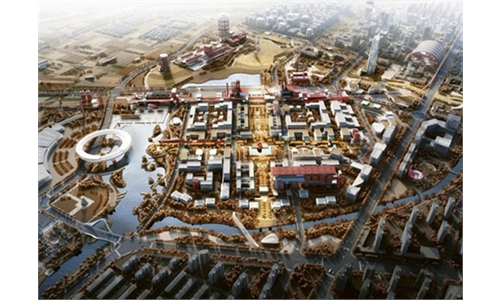
Partially cut-off trees on a street in Heliopolis, Cairo, capital of Egypt on January 27, 2020 Photo: AFP
In Cairo's busy streets, towering palms, purple-blossomed jacarandas and mature sycamore trees provide precious respite from the midday sun and a glimpse of green in the tangle of concrete and cars.But as Egypt's government powers ahead with ambitious urban development plans, including road and rail links for a new administrative capital, thousands of Cairo's trees have been cut down, angering residents and green activists.
"Cairo is already suffocating," said Rim Hamdy, a botany professor at Cairo University in the nearby city of Giza who has been petitioning authorities to save a centuries-old sycamore tree near the university.
"Cutting down trees will make the city [feel] even hotter and worsen its pollution problems," she said.
In Cairo's eastern Heliopolis district alone, about 2,500 trees were cut down between 2019 and 2020 as part of road-widening works, according to the Heliopolis Heritage Initiative - a group founded in 2011 to preserve local heritage.
About 10,000 square meters of the district's centuries-old Maryland park were bulldozed to establish a monument commemorating Cairo's road and bridge-building projects.
A nearby public nursery was razed to make way for a fuel station.
When local resident Tamer Sahab, 42, and fellow tree lovers heard that trees lining Heliopolis's famous Nehru street could be felled, they felt impelled to protest.
They attached banners to each of the trees, naming them after famous Egyptian figures, including kings, pharaohs and intellectuals.
"We wanted to say that trees are as important as humans," Sahab told the Thomson Reuters Foundation.
Police removed the banners a few days later and several of the group's members were reprimanded over the protest, but authorities acknowledged the importance of the trees in Nehru street and agreed not to cut them down.
COP27 climate talks
Such protests come as the attention of environmental policymakers around the world shifts to Egypt in 2022.
The country is due to host the next UN climate summit - COP27 - in Sharm el-Sheikh in November. Ahead of those talks, campaigners say the government's urban development plans run counter to its sustainability pledges.
The Environment Ministry did not respond to several requests for comment.
Much of the tree-felling in Cairo is related to the expansion of transport networks to cater for the new administrative capital, which is being built on the outskirts of Cairo and is due to be inaugurated in 2022.
Nearly four times the size of Washington DC, the new capital is designed to accommodate 6.5 million people and aims to ease Cairo's notorious congestion.
It will include a government district, home to all ministerial buildings and the parliament, and a financial and business district including the tallest tower in Africa.
Government officials have sought to highlight its green credentials, including parks, smart transportation and the use of renewable energy.
But critics of the urban development plans say they are at odds with the government's targets under the 2030 Sustainable Development Goals (SDGs).
Ahmed Elseidi, a lawyer specializing in environmental issues, filed a lawsuit in 2020 aimed at halting the felling of trees and destruction of public parks until an environmental impact evaluation is conducted. The lawsuit is still pending.
He said Egyptian law stipulates that any person or authority is obligated to submit a study to assess the environmental impact of their project before work can begin.
"Moving ahead with urban development projects without bearing in mind the environmental consequences contradicts [the government's] 2030 vision aimed at achieving the sustainable development goals," he added.
The SDGs emphasize the urgent need to tackle climate change and protect the environment through a shift to sustainable consumption and production, and wiser use of natural resources.
Public green space is already a scarce commodity in Egyptian cities.
Egypt has 5.4 million square meters of urban green areas such as parks, botanical gardens and zoos, less than 10 percent of what it needs to serve its population, according to the Central Agency for Public Mobilization and Statistics (CAPMAS), a state entity.
In Maadi, a suburb of southern Cairo, local resident Asma el Halwagy founded the Trees Lovers Association to campaign for some of the neighborhood's oldest trees to be saved from being cut down to make way for new infrastructure.
She said authorities have listened to some of the association's complaints about the development plans, noting that local officials were using a special machine to uproot mature trees and replant them elsewhere.
But moving established trees is not always effective.
"Growing new trees will require a lot of money for maintenance and amid climate changes their growing will face challenges," El Halwagy said.
Many tree species have vanished from Egyptian streets in recent years, said Hamdy, the botanist.
Reuters



